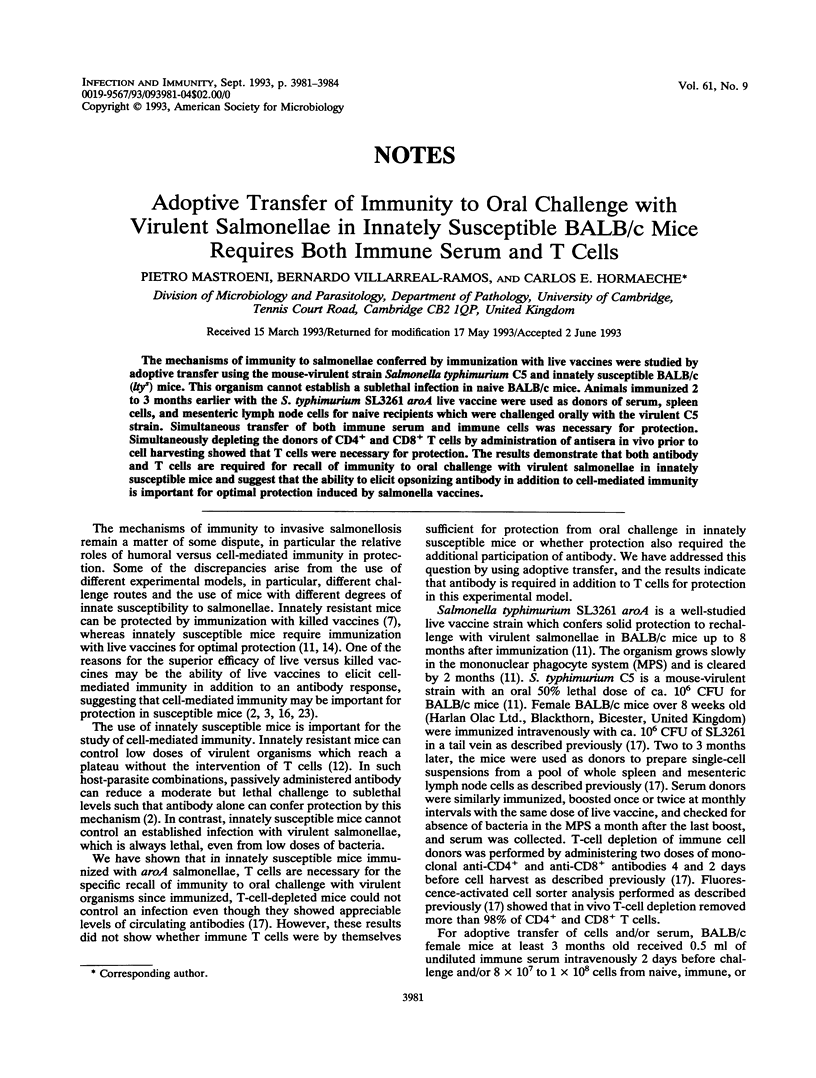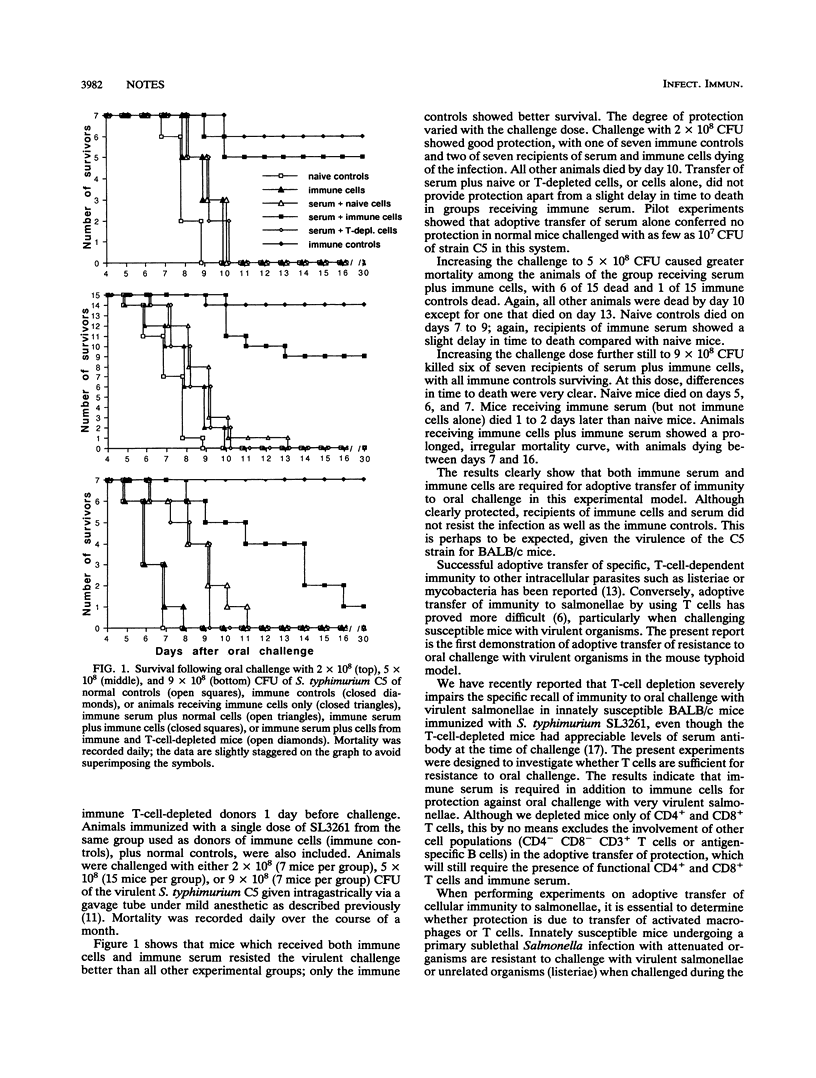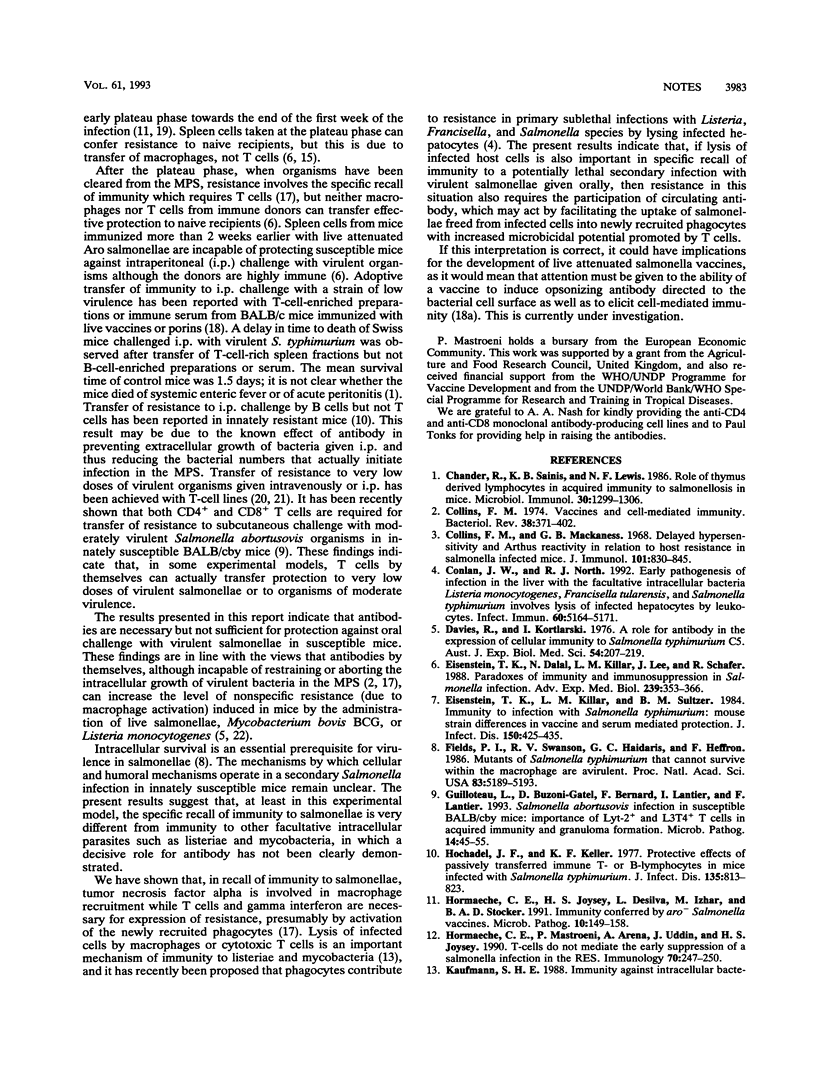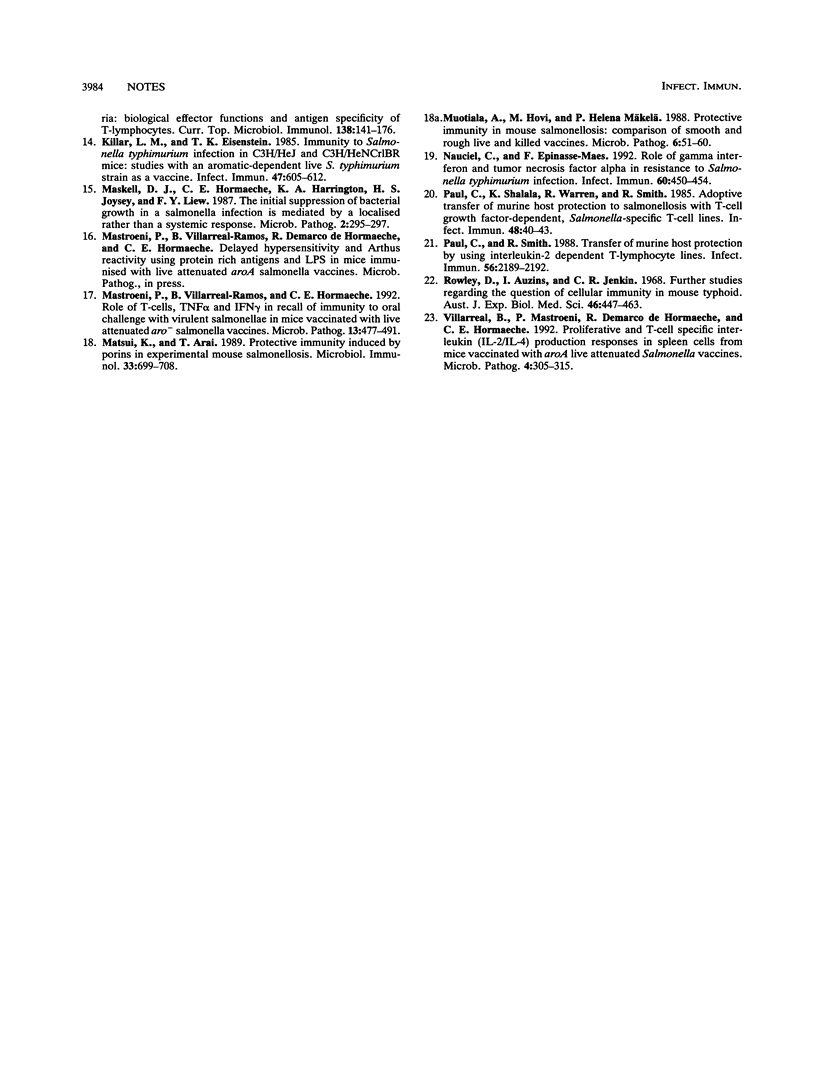Abstract
The mechanisms of immunity to salmonellae conferred by immunization with live vaccines were studied by adoptive transfer using the mouse-virulent strain Salmonella typhimurium C5 and innately susceptible BALB/c (ltys) mice. This organism cannot establish a sublethal infection in naive BALB/c mice. Animals immunized 2 to 3 months earlier with the S. typhimurium SL3261 aroA live vaccine were used as donors of serum, spleen cells, and mesenteric lymph node cells for naive recipients which were challenged orally with the virulent C5 strain. Simultaneous transfer of both immune serum and immune cells was necessary for protection. Simultaneously depleting the donors of CD4+ and CD8+ T cells by administration of antisera in vivo prior to cell harvesting showed that T cells were necessary for protection. The results demonstrate that both antibody and T cells are required for recall of immunity to oral challenge with virulent salmonellae in innately susceptible mice and suggest that the ability to elicit opsonizing antibody in addition to cell-mediated immunity is important for optimal protection induced by salmonella vaccines.
Full text
PDF



Selected References
These references are in PubMed. This may not be the complete list of references from this article.
- Chander R., Sainis K. B., Lewis N. F. Role of thymus-derived lymphocytes in acquired immunity to salmonellosis in mice. Microbiol Immunol. 1986;30(12):1299–1306. doi: 10.1111/j.1348-0421.1986.tb03062.x. [DOI] [PubMed] [Google Scholar]
- Collins F. M., Mackaness G. B. Delayed hypersensitivity and arthus reactivity in relation to host resistance in salmonella-infected mice. J Immunol. 1968 Nov;101(5):830–845. [PubMed] [Google Scholar]
- Collins F. M. Vaccines and cell-mediated immunity. Bacteriol Rev. 1974 Dec;38(4):371–402. doi: 10.1128/br.38.4.371-402.1974. [DOI] [PMC free article] [PubMed] [Google Scholar]
- Conlan J. W., North R. J. Early pathogenesis of infection in the liver with the facultative intracellular bacteria Listeria monocytogenes, Francisella tularensis, and Salmonella typhimurium involves lysis of infected hepatocytes by leukocytes. Infect Immun. 1992 Dec;60(12):5164–5171. doi: 10.1128/iai.60.12.5164-5171.1992. [DOI] [PMC free article] [PubMed] [Google Scholar]
- Davies R., Kotlarski I. A role for antibody in the expression of cellular immunity to Salmonella typhimurium C5. Aust J Exp Biol Med Sci. 1976 Jun;54(3):207–219. doi: 10.1038/icb.1976.22. [DOI] [PubMed] [Google Scholar]
- Eisenstein T. K., Dalal N., Killar L., Lee J. C., Schafer R. Paradoxes of immunity and immunosuppression in Salmonella infection. Adv Exp Med Biol. 1988;239:353–366. doi: 10.1007/978-1-4757-5421-6_34. [DOI] [PubMed] [Google Scholar]
- Eisenstein T. K., Killar L. M., Sultzer B. M. Immunity to infection with Salmonella typhimurium: mouse-strain differences in vaccine- and serum-mediated protection. J Infect Dis. 1984 Sep;150(3):425–435. doi: 10.1093/infdis/150.3.425. [DOI] [PubMed] [Google Scholar]
- Fields P. I., Swanson R. V., Haidaris C. G., Heffron F. Mutants of Salmonella typhimurium that cannot survive within the macrophage are avirulent. Proc Natl Acad Sci U S A. 1986 Jul;83(14):5189–5193. doi: 10.1073/pnas.83.14.5189. [DOI] [PMC free article] [PubMed] [Google Scholar]
- Guilloteau L., Buzoni-Gatel D., Bernard F., Lantier I., Lantier F. Salmonella abortusovis infection in susceptible BALB/cby mice: importance of Lyt-2+ and L3T4+ T cells in acquired immunity and granuloma formation. Microb Pathog. 1993 Jan;14(1):45–55. doi: 10.1006/mpat.1993.1005. [DOI] [PubMed] [Google Scholar]
- Hochadel J. F., Keller K. F. Protective effects of passively transferred immune T- or B-lymphocytes in mice infected with Salmonella typhimurium. J Infect Dis. 1977 May;135(5):813–823. doi: 10.1093/infdis/135.5.813. [DOI] [PubMed] [Google Scholar]
- Hormaeche C. E., Joysey H. S., Desilva L., Izhar M., Stocker B. A. Immunity conferred by Aro- Salmonella live vaccines. Microb Pathog. 1991 Feb;10(2):149–158. doi: 10.1016/0882-4010(91)90075-l. [DOI] [PubMed] [Google Scholar]
- Hormaeche C. E., Mastroeni P., Arena A., Uddin J., Joysey H. S. T cells do not mediate the initial suppression of a Salmonella infection in the RES. Immunology. 1990 Jun;70(2):247–250. [PMC free article] [PubMed] [Google Scholar]
- Killar L. M., Eisenstein T. K. Immunity to Salmonella typhimurium infection in C3H/HeJ and C3H/HeNCrlBR mice: studies with an aromatic-dependent live S. typhimurium strain as a vaccine. Infect Immun. 1985 Mar;47(3):605–612. doi: 10.1128/iai.47.3.605-612.1985. [DOI] [PMC free article] [PubMed] [Google Scholar]
- Maskell D. J., Hormaeche C. E., Harrington K. A., Joysey H. S., Liew F. Y. The initial suppression of bacterial growth in a salmonella infection is mediated by a localized rather than a systemic response. Microb Pathog. 1987 Apr;2(4):295–305. doi: 10.1016/0882-4010(87)90127-6. [DOI] [PubMed] [Google Scholar]
- Mastroeni P., Villarreal-Ramos B., Hormaeche C. E. Role of T cells, TNF alpha and IFN gamma in recall of immunity to oral challenge with virulent salmonellae in mice vaccinated with live attenuated aro- Salmonella vaccines. Microb Pathog. 1992 Dec;13(6):477–491. doi: 10.1016/0882-4010(92)90014-f. [DOI] [PubMed] [Google Scholar]
- Matsui K., Arai T. Protective immunity induced by porin in experimental mouse salmonellosis. Microbiol Immunol. 1989;33(9):699–708. doi: 10.1111/j.1348-0421.1989.tb00957.x. [DOI] [PubMed] [Google Scholar]
- Muotiala A., Hovi M., Mäkelä P. H. Protective immunity in mouse salmonellosis: comparison of smooth and rough live and killed vaccines. Microb Pathog. 1989 Jan;6(1):51–60. doi: 10.1016/0882-4010(89)90007-7. [DOI] [PubMed] [Google Scholar]
- Nauciel C., Espinasse-Maes F. Role of gamma interferon and tumor necrosis factor alpha in resistance to Salmonella typhimurium infection. Infect Immun. 1992 Feb;60(2):450–454. doi: 10.1128/iai.60.2.450-454.1992. [DOI] [PMC free article] [PubMed] [Google Scholar]
- Paul C. C., Norris K., Warren R., Smith R. A. Transfer of murine host protection by using interleukin-2-dependent T-lymphocyte lines. Infect Immun. 1988 Aug;56(8):2189–2192. doi: 10.1128/iai.56.8.2189-2192.1988. [DOI] [PMC free article] [PubMed] [Google Scholar]
- Rowley D., Auzins I., Jenkin C. R. Further studies regarding the question of cellular immunity in mouse typhoid. Aust J Exp Biol Med Sci. 1968 Aug;46(4):447–463. doi: 10.1038/icb.1968.38. [DOI] [PubMed] [Google Scholar]
- Villarreal B., Mastroeni P., de Hormaeche R. D., Hormaeche C. E. Proliferative and T-cell specific interleukin (IL-2/IL-4) production responses in spleen cells from mice vaccinated with aroA live attenuated Salmonella vaccines. Microb Pathog. 1992 Oct;13(4):305–315. doi: 10.1016/0882-4010(92)90040-u. [DOI] [PubMed] [Google Scholar]


